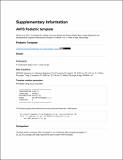| dc.contributor.author | Ghosh, SS | |
| dc.contributor.author | Kakunoori, S | |
| dc.contributor.author | Augustinack, Jean | |
| dc.contributor.author | Nieto-Castanon, Alfonso | |
| dc.contributor.author | Kovelman, Ioulia | |
| dc.contributor.author | Gaab, Nadine | |
| dc.contributor.author | Christodoulou, Joanna A. | |
| dc.contributor.author | Triantafyllou, Christina | |
| dc.contributor.author | Gabrieli, John | |
| dc.contributor.author | Fischl, Bruce | |
| dc.date.accessioned | 2013-01-02T00:49:07Z | |
| dc.date.available | 2013-01-02T00:49:07Z | |
| dc.date.issued | 2010-10-15 | |
| dc.identifier.uri | http://hdl.handle.net/1721.1/75815 | |
| dc.description | ANTS template created for use in the published article | en_US |
| dc.description.abstract | Understanding the neurophysiology of human cognitive development relies on methods that enable accurate comparison of structural and functional neuroimaging data across brains from people of different ages. A fundamental question is whether the substantial brain growth and related changes in brain morphology that occur in early childhood permit valid comparisons of brain structure and function across ages. Here we investigated whether valid comparisons can be made in children from ages 4 to 11, and whether there are differences in the use of volume-based versus surface-based registration approaches for aligning structural landmarks across these ages. Regions corresponding to the calcarine sulcus, central sulcus, and Sylvian fissure in both the hemispheres were manually labeled on T1-weighted structural magnetic resonance images from 31 children ranging in age from 4.2 to 11.2 years old. Quantitative measures of shape similarity and volumetric-overlap of these manually labeled regions were calculated when brains were aligned using a 12-parameter affine transform, SPM's nonlinear normalization, a diffeomorphic registration (ANTS), and FreeSurfer's surface-based registration. Registration error for normalization into a common reference framework across participants in this age range was lower than commonly used functional imaging resolutions. Surface-based registration provided significantly better alignment of cortical landmarks than volume-based registration. In addition, registering children's brains to a common space does not result in an age-associated bias between older and younger children, making it feasible to accurately compare structural properties and patterns of brain activation in children from ages 4 to 11. | en_US |
| dc.publisher | Neuroimage, Elsevier | en_US |
| dc.rights | Attribution 3.0 United States | en |
| dc.rights.uri | http://creativecommons.org/licenses/by/3.0/us/ | en |
| dc.subject | ANTS | en_US |
| dc.subject | Template | en_US |
| dc.subject | Normalization | en_US |
| dc.title | Supplementary Material: Evaluating the validity of volume-based and surface-based brain image registration for developmental cognitive neuroscience studies in children 4 to 11 years of age | en_US |
| dc.type | Dataset | en_US |
| dc.identifier.citation | Ghosh, Satrajit S., et al. "Evaluating the validity of volume-based and surface-based brain image registration for developmental cognitive neuroscience studies in children 4 to 11years of age." NeuroImage 53.1 (2010): 85-93. | en_US |
